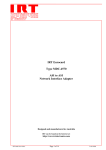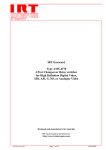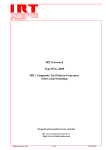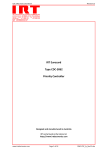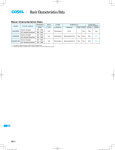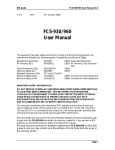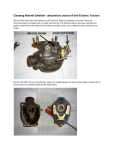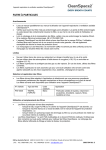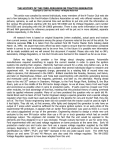Download User Manual - IRT Communications
Transcript
I R T Electronics Pty Ltd A.B.N. 35 000 832 575 26 Hotham Parade, ARTARMON N.S.W. 2064 AUSTRALIA National: Phone: (02) 9439 3744 Fax: (02) 9439 7439 International: +61 2 9439 3744 +61 2 9439 7439 Email: [email protected] Web: www.irtelectronics.com IRT Eurocard Type DDA-4006 270 Mb/s ASI/SDI 8 O/P Non-Reclocking Distribution Amplifier Designed and manufactured in Australia IRT can be found on the Internet at: http://www.irtelectronics.com 4006-dda.ib.rev1.doc Page 1 of 12 10/09/2008 DDA-4006 270 Mb/s ASI/SDI 8 O/P Non-Reclocking Distribution Amplifier Instruction Manual Table of Contents Section Page Operational Safety General Description Technical Specifications Installation Link Settings Digital Video Connections Front Panel Indicators SMU-4000 Installation Figure 1: SMU-4000 module Front & rear panel connector diagrams SNMP – What Is It? DDA-4006 SNMP Functions Maintenance & Storage Warranty and Service Equipment return Drawing Index 2 3 4 5 5 5 5 6 6 7 8 10 11 11 11 12 This instruction manual applies to DDA-4006 later than S/N 0806101 Operational Safety: WARNING Operation of electronic equipment involves the use of voltages and currents that may be dangerous to human life. Note that under certain conditions dangerous potentials may exist in some circuits when power controls are in the OFF position. Maintenance personnel should observe all safety regulations. Do not make any adjustments inside equipment with power ON unless proper precautions are observed. All internal adjustments should only be made by suitably qualified personnel. All operational adjustments are available externally without the need for removing covers or use of extender cards. 4006-dda.ib.rev1.doc Page 2 of 12 10/09/2008 DDA-4006 270 Mb/s ASI/SDI 8 O/P Non-Reclocking Distribution Amplifier General Description BLOCK DIAGRAM DDA-4006 SIGNAL PATH OUTPUTS Relay Bypass on loss of power O/P 1 O/P 2 O/P 3 O/P 4 INPUT EQUALISER O/P 5 O/P 6 SIGNAL FAIL DETECTION O/P 7 O/P 8 SNMP MON O/P LINK RL 1 RL1 ALARM O/P Relay RL 1 = Output Alarm The DDA-4006 270 Mb/s serial digital video distribution amplifier provides the user with a single standard module to cover a wide range of distribution and monitoring functions for ASI or SDI signals. Due to the fact that standard loop through techniques used in the analogue domain are unsuitable to the digital domain most digital equipment comes with no facility to route the input signal to other locations. As a result a DA is required at almost every point in the digital chain. Serial digital signals also suffer severe deterioration over relatively short cable distances. The DDA-4006 provides a means of extending the working distances that can be achieved by equalising and re-transmitting the data mid route. The DDA-4006 may also be used to provide input equalisation for devices not having this feature, as most unequalised inputs will only support cable lengths of less than 20 metres. Frequent re-clocking of serial digital signals can lead to serious increases in jitter with resultant data errors. The DDA-4006 does not include re-clocking so as to minimise these errors, leaving re-clocking to be done by the receiving device. For applications requiring reclocking the DDA-4007 should be used. The rear assembly now includes a bypass relay, to switch the Input (SK1) to Output 1 (SK2) in the event of a power failure, as standard. An optional Simple Network Management Protocol (SNMP) plug-in module is available for remote monitoring of input status and alarm state. The DDA-4006 is designed to fit IRT’s Standard Eurocard frame as well as IRT’s 4000 series frame for use with IRT’s SNMP system and may be used alongside any other of IRT’s analogue or digital Eurocards. Features: • • • • • • • For use as buffer or distribution amplifier. 8 in-phase 270 Mb/s ASI or SDI reclocked outputs. Automatic input equalisation to 250 metres. Automatic output muting on no input. Relay bypass on loss of power. Front panel indicators provide monitoring of presence of input signal at 270 Mb/s. Optional plug-in SNMP monitoring module. 4006-dda.ib.rev1.doc Page 3 of 12 10/09/2008 Technical Specifications DDA-4006 Input: Number Impedance Return loss 1. 75 Ohm. >15 dB 5 MHz to 270 MHz. Equalisation Automatic, better than 250 metres at 270 Mb/s for Belden 8281 or equivalent cable (reduces to approx. 200m when LK2 is closed). Outputs: Number Signal level Impedance Return loss DC offset 8 ASI or SDI plus one front panel monitoring output. 800 mV ± 10%. 75 Ohm. >15 dB 5 MHz to 270 MHz. Nil. Performance: Output rise time Residual Jitter <1 ns, (700 ps typically). <0.1 UI (measured with up to 300m of Belden 8281 or equivalent cable). Connectors: BNC. Indicators: Power Signal present Power requirement: Voltage Consumption LED (green) for +5 Vdc. LED (green) when signal present. 28 Vac CT (14-0-14) or ±16 Vdc. 2.0 VA. General: Temperature range Mechanical Dimensions Weight Finish: Front panel Rear assembly Supplied accessories Optional accessories 0 - 50° C ambient. Suitable for mounting in IRT 19" rack chassis with input, output and power connections on the rear panel. 6 HP x 3U Extended Eurocard (220 mm x 100 mm). With rear assembly 340g. Grey background, silk-screened black lettering & red IRT logo. Detachable silk-screened PCB with direct mount connectors to Eurocard and external signals. Rear connector assembly with matching connector for alarm outputs. SMU-4000 SNMP plug-in module for use with 4000 series frame fitted with SNMP “Agent”. Due to our policy of continuing development, these specifications are subject to change without notice. 4006-dda.ib.rev1.doc Page 4 of 12 10/09/2008 Installation Pre-installation: Handling: This equipment may contain or be connected to static sensitive devices and proper static free handling precautions should be observed. Where individual circuit cards are stored, they should be placed in antistatic bags. Proper antistatic procedures should be followed when inserting or removing cards from these bags. Power: AC mains supply: Ensure that operating voltage of unit and local supply voltage match and that correct rating fuse is installed for local supply. DC supply: Ensure that the correct polarity is observed and that DC supply voltage is maintained within the operating range specified. Earthing: The earth path is dependent on the type of frame selected. In every case particular care should be taken to ensure that the frame is connected to earth for safety reasons. See frame manual for details. Signal earth: For safety reasons a connection is made between signal earth and chassis earth. No attempt should be made to break this connection. Installation in frame or chassis: See details in separate manual for selected frame type. Link Settings: LK1 is factory set for a contact make to ground on signal failure at SK10 pin 2 on the rear panel, move LK1 from the normally closed (N/C) to the normally open (N/O) position for a break to ground on signal or power loss. Link LK2 closed reduces the input equalisation to 200m for use in noisy environments or when a short input cable is used. Digital Video Connections: Input and outputs are 75 Ω BNC type for connection with high quality 75 Ω coaxial cable. Input is self-terminating. Front Panel Indicators: The presence of 270 Mb/s locked signal is indicated by the ‘SIGNAL PRESENT’ front panel LED (green). The presence of the internal +5 Vdc supply is indicated by the front panel LED (green). 4006-dda.ib.rev1.doc Page 5 of 12 10/09/2008 SMU-4000 Installation The SMU-4000 plug-in SNMP management controller module can only be fitted to IRT’s 4000 series modules that are capable of being SNMP upgradeable. To determine whether a module is SNMP upgradeable, a square section on the main PCB is silk screened and fitted with three multipin sockets – as shown below: 1J1 1J3 1J2 This is where the SMU-4000 plug-in SNMP management controller module is fitted. The three sets of multipins on the underside of the SMU-4000 line up with the three sets of multipin sockets on the main PCB module. Align all pins and then gently press the SMU-4000 all the way down into place. If the SMU-4000 is not already programmed with the correct firmware to match the module that it is being plugged into, it then needs to be programmed via the pins on the topside of the SMU-4000. Note that installation will generally be done by IRT Electronics at the time of ordering. Note also that an SMU-4000 will only be functionally operational when the main module that it is plugged into is fitted into an IRT 4000 series frame fitted with a CDM-4000 SNMP agent and being interrogated by a suitable Network Management System. Figure 1: SMU-4000 module 4006-dda.ib.rev1.doc Page 6 of 12 10/09/2008 Front & rear panel connector diagrams The following front panel and rear assembly drawings are not to scale and are intended to show relative positions of connectors, indicators and controls only. DD A - 4 0 0 6 OUTPUTS POWER OFF BYPASS SK1-SK2 SK8 SK9 PL2 SK7 SK6 SIGNAL PRESENT SK4 SK5 SK3 SK2 OUTPUT MON DC 2 SK1 1 SK10 SK10 2 = Alarm SK10 1 = Gnd INPUT PL 5 OUT PL1 N140 4006-dda.ib.rev1.doc Page 7 of 12 10/09/2008 SNMP What Is It? SNMP stands for Simple Network Management Protocol. It is an application layer protocol for managing IP (Internet Protocol) based systems. SNMP enables system administrators to manage system performance, and to find and solve system problems. SNMP runs over UDP (User Datagram Protocol), which in turn runs over IP. Three types of SNMP exist: SNMP version 1 (SNMPv1), SNMP version 2 (SNMPv2) and SNMP version 3 (SNMPv3). It is not the intention here to discuss the differences between various versions, only to bring attention to the fact that IRT Electronics modules, fitted with SNMP capability, use SNMPv1. An SNMP managed network consists of three key components: Network Management Systems (NMS), agents, and managed devices. An NMS is the console through which the network administrator performs network management functions, such as monitoring status (e.g. alarm states) and remote controlling, of a set of managed devices. One or more NMSs must exist on any managed network. Generally the NMS is a computer running third party SNMP control software. There are a number of third party SNMP software applications currently available on the market. An NMS polls, or communicates with, an agent. An agent is a network management software module that resides in a managed device. An agent has local knowledge of management information and translates that information into a form compatible with SNMP. The agent, therefore, acts as an interface between the NMS and the managed devices. The NMS sends a request message, and control commands for the managed devices, to the agent, which in turn sends a response message, containing information about the managed devices, back to the NMS. A managed device contains an SNMP agent and resides on a managed network. Managed devices collect and store management information and make this information available to NMSs using SNMP. Managed device agent variables are organised in a tree structure known as a Management Information Base (MIB). Within the MIB are parameters pertaining to the managed device. An Object Identifier (OID) number within the MIB defines the managed device type. This is a unique number specific to the model of managed device. Other information relating to the device is also stored, information such as alarm states, controllable settings, etc. The MIB tree is organised in such a way that there will be no two MIB files with conflicting placements. Normally an NMS polls an agent for information relating to the MIB in a managed device to be sent back to the NMS. When certain conditions are met within the MIB, such as major alarm conditions, for example, the agent automatically sends what is known as a trap to the NMS without any prompting from the NMS. This allows automatic notification of a predetermined event. SNMP Block Diagram NMS IP Network NMS 4006-dda.ib.rev1.doc Page 8 of 12 SNMP Agent Protocol Engine MIB SNMP Agent SNMP Agent Protocol Engine MIB SNMP Agent SNMP Agent Protocol Engine MIB SNMP Agent 10/09/2008 SNMP with IRT Products IRT Electronics currently employs SNMPv1 with its 4000 series frame. The frame acts as an agent when fitted with a CDM-4000 module. This module has its own designated slot next to the power supply so as to not affect the number of modules that the frame will take. Communication between the NMS, the frame and its loaded modules are via this CDM-4000 module. Note that the NMS software is third party and not supplied by IRT Electronics. Ethernet connection for SNMP operation is via an RJ45 connector on the rear of the frame, below the mains inlet. Ethernet rate runs at either 10 baseT or 100 baseT. Frame parameters, such as Name, Address and Location, are set via an RS232 interface, a D9 connector on the rear of the frame below the mains inlet. A software terminal emulator, such as Tera Term or HyperTerminal, is used for setting and reading the parameters of the frame. IRT modules that are SNMP compatible need a plug-in SMU-4000 module with a program relevant to the module that it is plugged into. Depending on the module, besides the module identification, parameters such as alarm states, inputs and controls etc. are communicated to the CDM-4000 agent via a data bus on the rear of the frame. Thus the CDM-4000 collects information on what is loaded within the frame, what positions they occupy, and their current status for communication to the NMS when the NMS sends a request for information. In the event of a major alarm from any of the SNMP compatible modules, or power supplies, a trap is automatically sent by the CDM-4000 agent to the NMS without any prompting by the NMS. This alerts the operator to any fault conditions that may exist that need immediate attention. 110/240 V 50/60 Hz 0.7 A (max.) FRU-4000 FRAME FUSES 220/240 Vac 500 mA S.B. 110/120 Vac 1A S.B. RS232 Alarm Ethernet + 48Vdc AS3260 approval no.: CS6346N Ass. no.: 804692 IRT SNMP Connections IRT modules fitted with SMU-4000 NMS Ethernet Cable IP Network CDM-4000 PSU’s IRT 4000 Series Frame Ethernet Cable IRT modules fitted with SMU-4000 CDM-4000 PSU’s IRT 4000 Series Frame Ethernet Cable IRT 4000 Series SNMP Setup 4006-dda.ib.rev1.doc Page 9 of 12 10/09/2008 DDA-4006 SNMP Functions: With the DDA-4006 fitted with the optional plug-in SMU-4000 SNMP module, programmed with firmware to suit, and installed in an IRT 4000 series frame with SNMP capability, it is possible to remotely monitor the presence of an input and the state of the urgent alarm using an NMS. Traps can also be set for whenever an urgent alarm occurs or clears. 4006-dda.ib.rev1.doc Page 10 of 12 10/09/2008 Maintenance & Storage Maintenance: No regular maintenance is required. Care however should be taken to ensure that all connectors are kept clean and free from contamination of any kind. This is especially important in fibre optic equipment where cleanliness of optical connections is critical to performance. Storage: If the equipment is not to be used for an extended period, it is recommended the whole unit be placed in a sealed plastic bag to prevent dust contamination. In areas of high humidity a suitably sized bag of silica gel should be included to deter corrosion. Where individual circuit cards are stored, they should be placed in antistatic bags. Proper antistatic procedures should be followed when inserting or removing cards from these bags. Warranty & Service Equipment is covered by a limited warranty period of three years from date of first delivery unless contrary conditions apply under a particular contract of supply. For situations when “No Fault Found” for repairs, a minimum charge of 1 hour’s labour, at IRT’s current labour charge rate, will apply, whether the equipment is within the warranty period or not. Equipment warranty is limited to faults attributable to defects in original design or manufacture. Warranty on components shall be extended by IRT only to the extent obtainable from the component supplier. Equipment return: Before arranging service, ensure that the fault is in the unit to be serviced and not in associated equipment. If possible, confirm this by substitution. Before returning equipment contact should be made with IRT or your local agent to determine whether the equipment can be serviced in the field or should be returned for repair. The equipment should be properly packed for return observing antistatic procedures. The following information should accompany the unit to be returned: 1. 2. 3. 4. 5. 6. 7. A fault report should be included indicating the nature of the fault The operating conditions under which the fault initially occurred. Any additional information, which may be of assistance in fault location and remedy. A contact name and telephone and fax numbers. Details of payment method for items not covered by warranty. Full return address. For situations when “No Fault Found” for repairs, a minimum charge of 1 hour’s labour will apply, whether the equipment is within the warranty period or not. Contact IRT for current hourly rate. Please note that all freight charges are the responsibility of the customer. The equipment should be returned to the agent who originally supplied the equipment or, where this is not possible, to IRT direct as follows. Equipment Service IRT Electronics Pty Ltd 26 Hotham Parade ARTARMON N.S.W. 2064 AUSTRALIA Phone: Email: 4006-dda.ib.rev1.doc 61 2 9439 3744 [email protected] Page 11 of 12 Fax: 61 2 9439 7439 10/09/2008 Drawing Index Note: Components marked n/c on the diagrams are optional and are not included on standard production units. They are shown to assist with interpretation of additional or optional functions, which may be included or are necessary for factory set-up procedures. Drawing # Sheet # Description 804936 1 DDA-4006 Circuit Schematic 4006-dda.ib.rev1.doc Page 12 of 12 10/09/2008 PCB 804937 'SIGNAL' 'DC' LD2 HLMP-1503 'grn' R35 680R +5V 2 LD1 HLMP-1503 'grn' R36 680R +5V SK101 2 1 22R R41 1 1 R6 10K 2 2 BAS16 D2 +5V +5V C11 100nF Input Carrier Detect +5V 1 2 4u7 RL1A V23026 C33 5 2 n.o. ALARM CIRCUIT 10 1 n.c. LK1 C41 GNDA C40 10nF 10nF TO GROUND ON ALARM, AS SET BY LK1 CONTACT CLOSURE (OR BREAK) RL1B AC 4 AC 3 GND 804936i3s3.sch AC 2 +5V AC 1 Power Supply Circuit Output 1 Output 2 Output 3 Output 4 Output 5 Output 6 Output 7 GND Monitor O/P Output 8 +5V Input Equaliser and Output Drivers 804936i3s2.sch Q1 BSS123 1 TX CD 804936i3s4.sch RX RELAY RA +5V 1 F5 RXE020 POLYFUSE 10nF 2 C39 1A 1B 2A 2B 3A 3B 4A 4B 5A 5B 6A 6B 7A 7B 8A 8B 9A 9B 10A 10B 11A 11B 12A 12B 13A 13B 14A 14B 15A 15B 16A 16B 17A 17B 18A 18B 19A 19B 20A 20B 21A 21B 22A 22B 23A 23B 24A 24B 25A 25B 26A 26B 27A 27B 28A 28B 29A 29B 30A 30B 31A 31B 32A 32B DIN64RA P1 DIN64 J1 1A 1B 2A 2B 3A 3B 4A 4B 5A 5B 6A 6B 7A 7B 8A 8B 9A 9B 10A 10B 11A 11B 12A 12B 13A 13B 14A 14B 15A 15B 16A 16B 17A 17B 18A 18B 19A 19B 20A 20B 21A 21B 22A 22B 23A 23B 24A 24B 25A 25B 26A 26B 27A 27B 28A 28B 29A 29B 30A 30B 31A 31B 32A 32B J1/32A R3R L3R R4R L4R R5R L5R R6R L6R R7R L7R R8R L8R R9R L9R 2 2 2 2 2 2 2 2 2 2 2 2 2 2 1 1 68R R1R 2 2 L1R 15nH 1 1 1 1 1 1 1 1 1 1 1 1 1 1 P3 6 4 2 1 SK10 SK3 SK4 SK5 SK6 SK7 SK8 1 2 3 1 3 5 7 9 2 RX OUTPUTS SK9 5 3 TX 1 P2 J2 2 03-04-2008 ECR1853 3 26-06-2008 ECR1863 K.N. Date: 10-Sep-2008 Revision: 3 ENG. APP. CHECKED DRAWN DO NOT COPY NOR DISCLOSE TO ANY THIRD PARTY WITHOUT WRITTEN CONSENT COPYRIGHT R1-R9 = 68R L1-L11 = 15nH 2 1 Sheet 1 of 4 DDA-4006 SDI/ASI Distribution Amplifier SK1 INPUT SK2 Drawing No. 804936 Title R10R 39R 2 1 L10R 15nH R11R 68R 2 2 1 L11R 15nH 1 IRT Electronics Pty. Ltd. ARTARMON NSW AUSTRALIA 2064 SCALE N.T.S. A3 SIZE J1/32A RL1R RELAY G6K-2F-RF 4 5 ALARM 3 6 2 1 2 1 2 1 3 1 2 7 MON. O/P 2 1 3 8 3 2 1 3 2 1 2 1 2 1 1 8 Control Interface 1 15-04-2004














